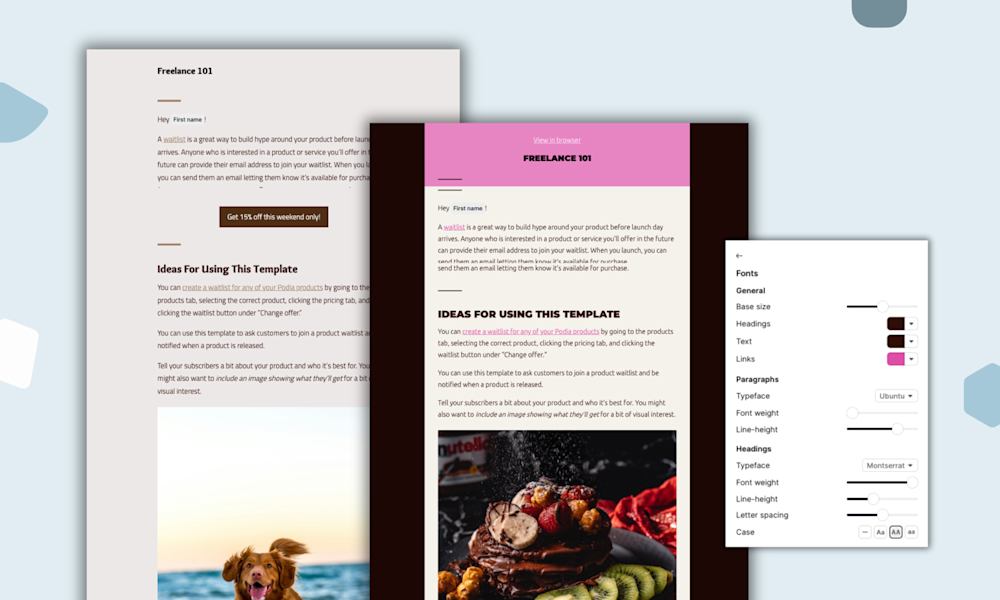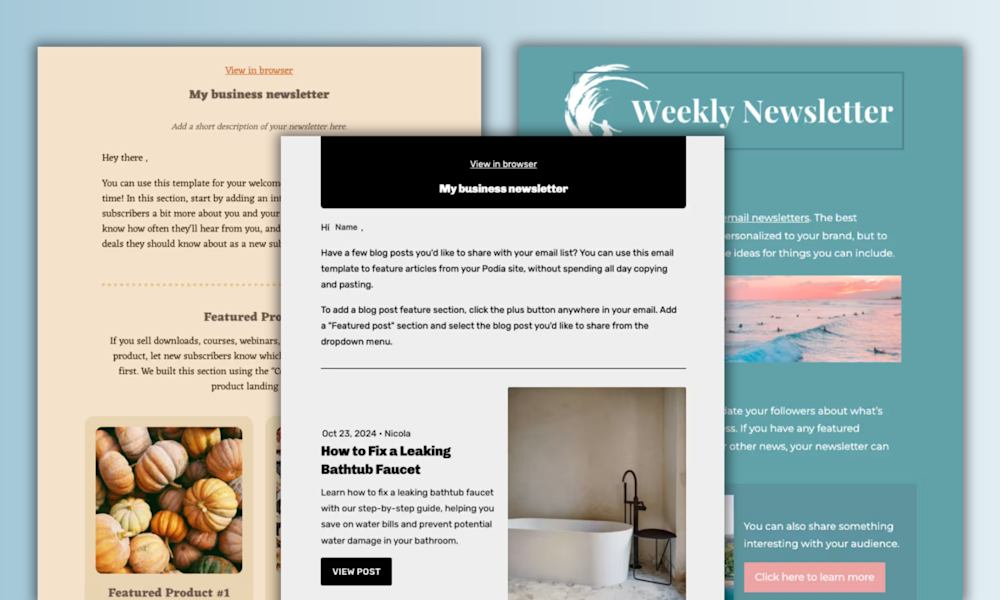Kit (formerly known as ConvertKit) is a popular email marketing platform among creators. It’s known for its visual automation builder, templated sign-up forms and landing pages, and detailed audience analytics, but is it the right choice for you?
In this Kit review, you’ll hear from 31 former Kit users about the things they liked, the things they didn’t like, and why they made the switch to Podia Email.
Your email marketing tool is one of the most important pieces of your online business — It’s how you’ll grow your audience, connect with followers, and promote your digital products. But important doesn’t have to mean complicated and expensive.
Ideally, your email marketing platform will have enough features to do what you want without being overwhelming. Bonus points if it doesn’t cost an arm and a leg.
While we were building Podia Email, we asked Podia users to share their experiences with other email platforms — both positive and negative — including Kit.
In this post, we share those findings, and we cover:
-
What Kit’s users like best about their email marketing tools
-
Where Kit’s previous customers ran into challenges with their product
-
Why some of those users decided to switch to Podia for their email marketing
While we’d obviously love for you to choose Podia, we’ve tried to give an honest review rather than simply critiquing Kit because we want you to find the right thing for your business, no matter what you choose.
Easy automations that do what you want them to do and unlimited landing pages that you can customize however you want - try Podia Email today with a free 30-day trial.
What are the best features of Kit (formerly ConvertKit)?
Kit is an email platform where creators can grow their audience, connect with followers, automate their email marketing, and earn money from digital products.
You can start by making embeddable email opt-in forms and standalone landing pages to direct people to your list. When you’re ready to send a broadcast or newsletter, Kit has a point-and-click email designer and a library of templates you can use as a starting point, or you can create a custom email from scratch.
You can also build automated campaigns using the visual automation builder and add tags and segments to your audience based on actions they take (like clicking a link in an email or purchasing a digital product).
Kit is primarily an email tool, so you’ll need to connect other software to run different aspects of your business. Luckily, they integrate with plenty of website platforms, course platforms, CRMs, landing page builders, and other resources.
Of all these Kit features, these are the things that our 31 survey respondents liked the most:
Kit has a free plan
Kit’s free plan lets you have up to 1,000 subscribers, and you can send unlimited broadcasts. You can make as many forms and landing pages as you like, but you won’t get access to automations or integrations at this tier.
That said, Kit’s free plan is a good way to test out the basic features of the platform, like the email builder and landing page designer, before committing to a paid plan.
Create visual automations
Kit is well known for its visual automation builder, which lets you build detailed pathways, workflows, and funnels for your subscribers. One previous user specifically mentioned that they liked having “multiple funnels, triggers, and tags” to work with, and you can use as many segments and tags as you like to organize your audience.
Kit shines for creators who need to build detailed customer journeys with multiple entrance and exit points, or who need hyper-specific automations to promote products.
Design emails and pages with pre-made templates
Other ex-users said they liked how Kit’s email editor and landing page builder had pre-designed templates so they could make emails, opt-in pages, and landing pages quickly.
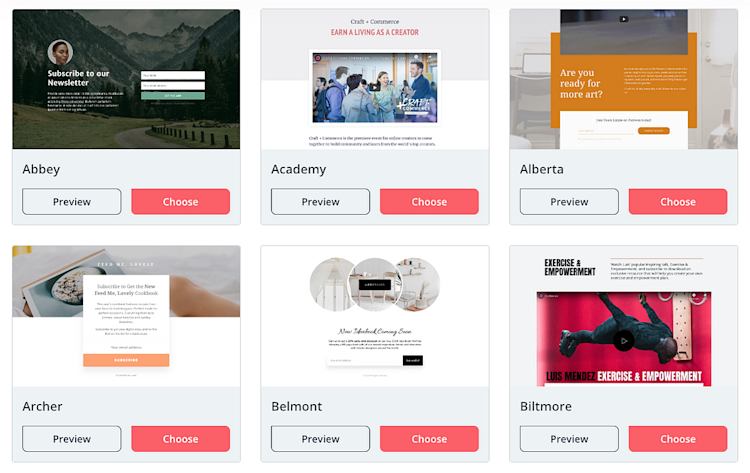
While there are limitations on what you can customize (particularly on your pages and forms, which we’ll discuss below), the designs look good out of the box. All you have to do is add your text, images, and links, and you’ll be on your way.
Kit also lets you make your own email templates that you can use again and again.
Track data and stats for each subscriber
Another area where Kit gets top marks is audience analytics. One respondent pointed out that they liked having “more information on each person in my audience, like where they click, which email they open, etc.”
You’ll have access to subscriber stats and subscriber scoring (available on the Creator Pro plan) so you can see lots of information about your audience. For example, you can see which opt-in forms are most popular, which subscribers have gone cold, and which emails have the highest deliverability and open rates.
As we mentioned earlier, you can also use Kit to create unlimited tags and segments for your audience, so you always send the right message to the right people.
What did previous customers not like about Kit?
On the flip side, the 31 former Kit users we surveyed weren’t fans of the expensive price, complex automations builder, and limitations with landing page designs.
Kit’s pricing is expensive
37% of past users said their biggest problem with Kit was the high price tag.

There is a free plan, but it only has basic features for up to 1,000 subscribers. If you want more functionality, you’ll need to choose a paid Creator or Creator Pro plan.
On both of these plans, pricing goes up as your list size increases. Here are some examples of what you can expect to pay on different Kit tiers:

So, what’s the difference between these plans?
With Kit’s free plan (up to 1,000 subscribers), you get:
-
Unlimited landing pages
-
Unlimited forms
-
Unlimited broadcasts
-
Audience tagging and segmentation
-
Sell digital products & subscriptions
-
Community support
With Creator, you get everything in free, plus:
-
Live chat & email support
-
Free migration from another tool
-
Automations
-
Third-party integrations
-
One additional team member
And with Creator Pro, you get everything in the previous two plans, plus:
-
Unlimited team members
-
Newsletter referral system
-
Subscriber scoring
-
Advanced reporting
It’s nice to have a free plan, but it won’t work for a lot of users because Kit gates important features like automations, integrations, and customer support to paid plans only.
You’ll have to pay at least $15/month (for the Creator plan with 300 subscribers) to start experimenting with automated campaigns or get help with your business.
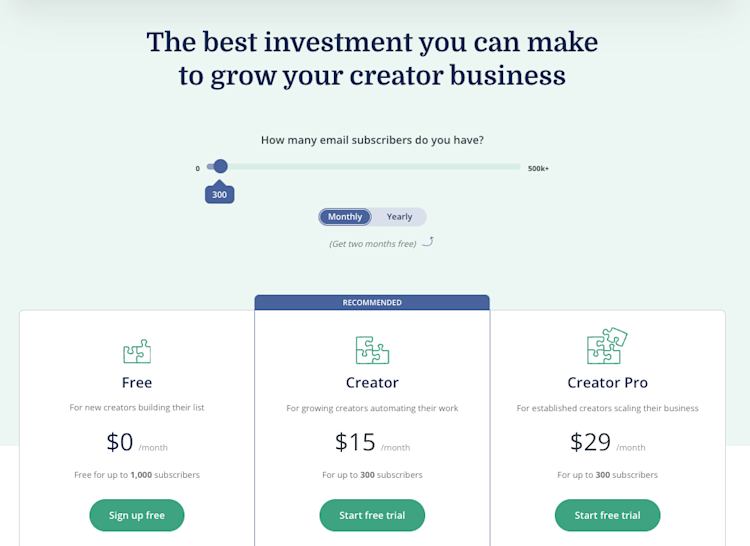
Plus, the visual automation builder is one of Kit’s main selling points, but it’s not available until you get on a Creator plan, which can drastically jump up in price as your list grows.
Building automations and funnels can get complicated
Speaking of the visual automation builder, many respondents found Kit’s automations too overwhelming to set up and manage. Some reviewers liked having lots of options, but other reviewers mentioned things like, “UI (user interface) was clunky” and “segmentation was so complicated” as their top cons.
While it’s true that you can do a lot of complex campaigns and workflows with Kit, most creators simply need a platform that can send emails and run some basic automations like welcome messages, sales funnels, and nurture sequences.
If it gets too complicated, email marketing can feel like a chore. Plus, no one likes logging into their email account and seeing a whole web of automations with no idea what anything does.
Creators typically don’t want their businesses to be more complicated, and there’s no reason to pay top dollar for features you don’t actually need. Unless you’re certain you need highly specific automations for your business, Kit could be more complicated and pricier than necessary.
Landing pages and opt-in forms have design limitations
It’s true that Kit has nice-looking landing page templates and email opt-in forms, but there are limits on what you can customize. As one past user noted, “I didn’t like the limitations on the opt-in forms I created, and the previews weren’t actual views.”
Currently, Kit doesn’t have a way to build landing pages or forms from scratch — you have to edit the existing templates that you’re given.
For instance, if you choose a landing page template with two columns, you only have the option to add elements (like images, buttons, dividers, or bulleted lists) within those columns. There’s no way to add additional sections beyond the base design. The options can feel limiting if you have a layout in mind that doesn’t align with a template.
Also, ConverKit’s landing pages are designed for email capture, not selling products or directing people to other URLs. Nearly all landing page templates have a prominent email opt-in form by default, and you’ll have to use custom CSS if you want to remove the email sign-up box from your page.
This makes it difficult to use Kit’s landing pages for anything outside of gathering emails, so you could end up needing to pay extra for a third-party landing page builder.
Why are people switching from Kit to Podia?
When asked why they switched from Kit to Podia, respondents highlighted the lower price point, simple email builder, and the ease of having everything in one place.
Podia is less expensive for nearly all users
Kit pricing goes up as you grow your list and upgrade to higher tiers, but Podia includes all email features on all plans. This means that your price only changes as your list grows, and creators with smaller lists have all the same advanced features as those with larger ones.
Unless you have between 100 and 1,000 subscribers, all Podia Email plans are less expensive than their Kit counterparts. Here are a few examples of how the pricing shakes out for Kit and Podia based on list size:
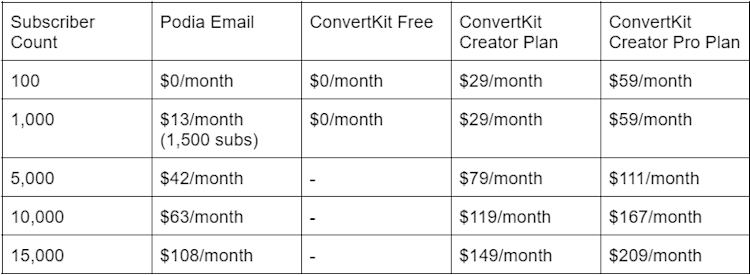
In addition to a lower price, Podia Email plans also have extra features for running your online business.
Podia Email can be purchased as an add-on to any Podia base plan. By default, all Podia Email plans include your full website, unlimited customizable landing pages, unlimited email opt-in forms, and the ability to sell a digital download and coaching product.
You can also run unlimited email automations on Podia’s plans – this feature is limited to paid plans with Kit.
Podia’s email editor is easy to use
Point, click, and customize. That’s all you need to do to make your emails look amazing in Podia. You can pick a professionally designed template, blank slate, or use a previous email as a starting point so you don’t have to reinvent the wheel each time you send a message.
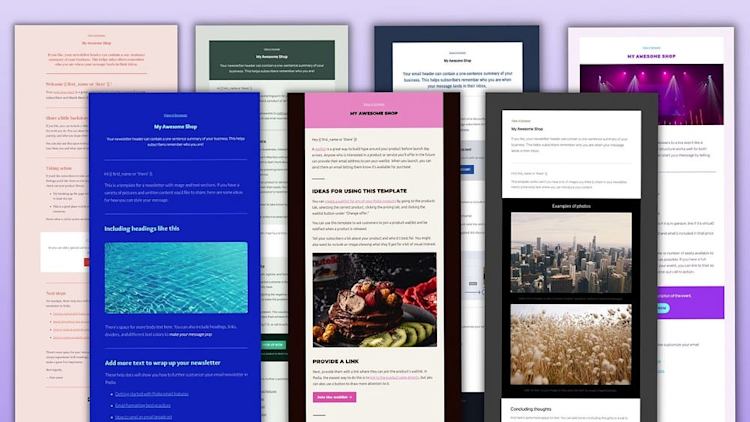
Make a design you love? You can use it as a custom template in your broadcasts or email campaigns as many times as you like.
Within your emails, you can add text sections, columns, featured callouts, social media links, videos, CTAs, and files for your customers to download.
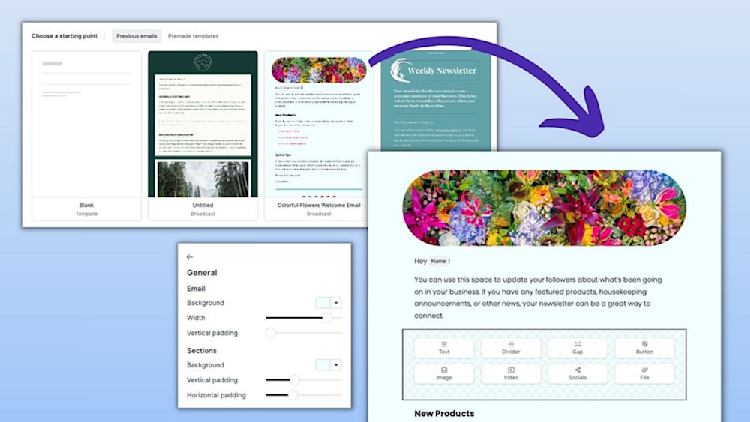
Plus, Podia’s email templates come with advice for what to write in addition to design elements, so you’ll never have to worry about knowing what to say.
Podia lets you run your business all in one place
Over half of the people surveyed (54%) said that the number one reason they switched from Kit to Podia was that they wanted to run all aspects of their business in one place.
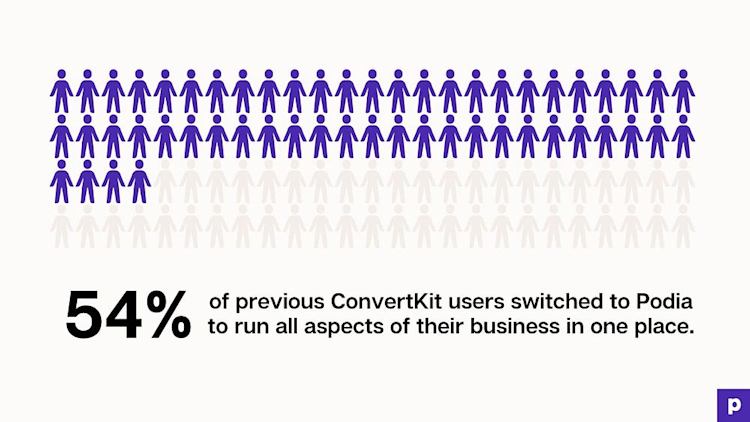
Kit is a great option for email marketing, but the ecommerce features are limited and there’s no website or community tool. Many of the creators we heard from found Podia’s all-in-one approach to be more straightforward and cost-effective since they didn’t have to connect (and pay for) a ton of extra tools.
With Podia, your products, customers, landing pages, opt-in forms, courses, affiliates, and website are all already connected to your email marketing.
This means you can customize the way you email your followers based on whether or not they’ve bought a product, joined a waitlist, or expressed interest in a particular topic without lots of complicated tags and integrations.
Let’s say you wanted to set up a waitlist for an online course you plan to sell.
In Kit, you’d need to set up an opt-in form or landing page specifically for your waitlist and tag any subscribers who join through that form. During the launch, you can send messages to the people with this tag to promote the product.
But once the course is live, you probably don’t want to keep messaging people who have already purchased it, so you will need to integrate Kit with your online course platform. You would then need to set up another tag for people who have made a purchase and use that tag to exclude them from any future promotional messages you send to waitlist members.
In Podia, your course, email, and customers are already in the same place. All you need to do is set up the course and put it in waitlist mode. Podia automatically generates a landing page for the course and anyone who signs up will be added to that course’s waitlist.
From there, you can send messages or campaigns to people on that waitlist using Podia’s easy audience filters. Once the course is live, Podia automatically tracks people who have purchased it. Once again, you can use audience filters to exclude people who already have the product from future emails.
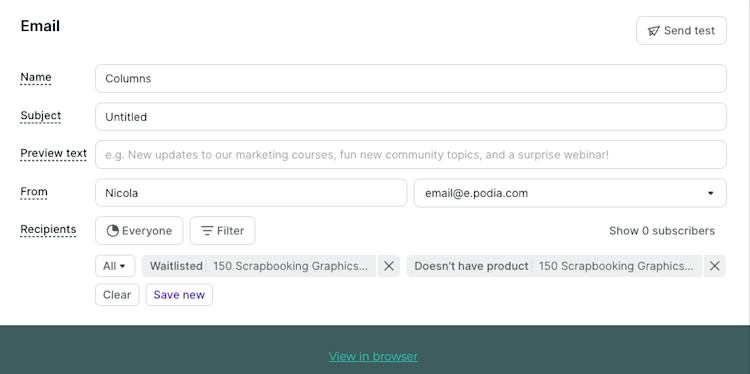
You don’t have to do any fancy setup behind the scenes or remember what a dozen different tags mean, and you won’t have to worry about getting your wires crossed since Podia has all the information about your customers in one place.
Here are some ways Podia’s all-in-one platform can make life easier:
-
Run automated welcome emails whenever someone joins your email list
-
Automatically send customized email sequences to customers after they purchase a particular product
-
Message only people who have (or haven’t) purchased a product
-
Follow up with people who have joined your waitlist. Podia’s waitlist feature is available on all plans, including the free plan
-
Set up lead magnets that funnel people into automated marketing automations
-
Use link clicks to add tags to subscribers, then create automated email sequences about the topics they’re interested in
Having everything in one place makes it easier to keep an eye on your customer data, too. With Podia, you can see all your metrics, like open rates, new subscribers, purchases, and income generated from each email, in one dashboard.
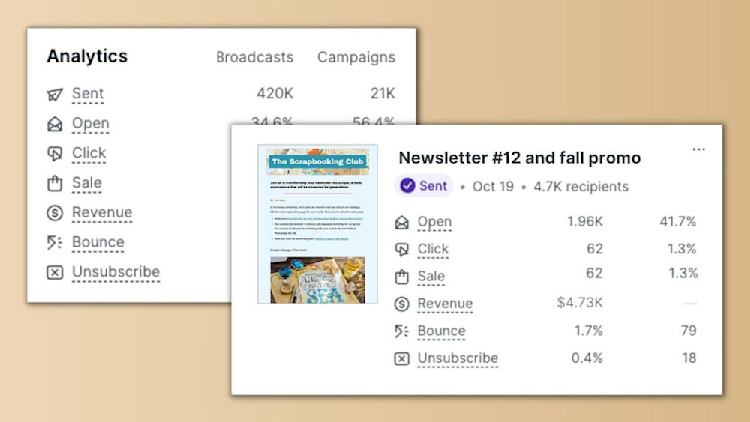
If you want to consolidate your online business into one place and get rid of extra fees and integrations, Podia could be the right fit for you too.
Is Kit right for me?
Kit is a great option for content creators and small business owners who need an email service provider with lots of complex automations. It comes at a steeper price point than platforms like Podia, but it might be worth it for you if you need a visual automation builder. Kit is also a good choice if you only want landing pages for collecting emails (not selling products) since that’s what Kit’s templates are set up for.
Podia is a better option for online creators who want to simplify their business with everything in one place. You can create unlimited emails and campaigns, use beautiful email templates (or design your own), build a full website, set up landing pages from scratch for any purpose you need them for, and sell any kind of product you imagine.
Since you won’t need lots of extra tools and plugins, your overall business expenses will likely be lower than they would be if you cobbled everything together yourself.
For affordable, easy-to-use, and powerful marketing features that don’t feel overwhelming, give Podia a try. Get started today with a free 30-day trial.
We can’t wait to see what you make.
Email marketing FAQs
What is ConvertKit?
ConvertKit (now known as Kit) is an email marketing platform that lets you grow your email list through sign-up forms and landing pages, create automated campaigns, send broadcasts, and sell digital downloads. There’s a limited free plan for up to 1,000 subscribers, and paid plans start at $15 per month.
What are some Kit alternatives?
Unsurprisingly, our favorite Kit alternative is Podia Email! You can also read about other email marketing tools similar to Kit in these guides.
What are the benefits of Kit?
Kit lets you send unlimited broadcast messages and create unlimited campaigns. There are pre-designed email templates, an easy email builder, and a visual automation builder. You can also sell digital downloads using the ecommerce feature.
What are the disadvantages of Kit?
Kit works well for managing your email, but you’ll need to connect other tools to build your website and sell products beyond downloads. More tools mean more tech you’ll need to manage and potentially more fees. Plus, Kit’s pricing gets expensive as your list grows and as you need more features.
What is the best email marketing software?
We’re a little biased here, but we think Podia Email is the best email marketing service around. With Podia Email, you get a beautiful email builder, templates, and unlimited email sends on all plans. You can also make email marketing campaigns and see how much money you earn from each email. Podia Email is automatically connected to your website, landing pages, products, courses, customers, and everything else. Check it out for yourself with a free 30-day trial.
